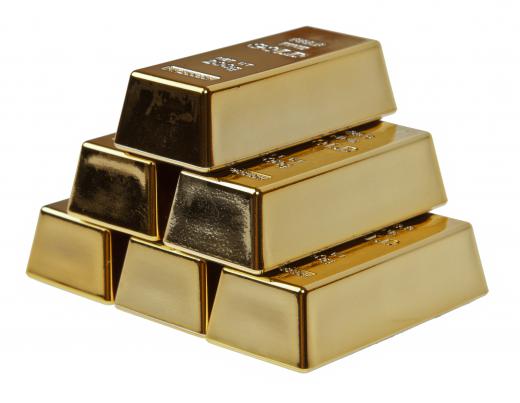What is Gold?
 Mary Elizabeth
Mary Elizabeth
Gold is a metallic element with the atomic number 79 and the symbol Au. While the name gold comes from an Old English word meaning yellow, the symbol comes from the Latin aurum, which means “shining dawn.”
On the periodic table of elements, gold is found in Group 11, along with silver, copper, and roentgenium, and in Period 6 between platinum and mercury. It is referred to as a “transition metal” and is the most malleable, ductile metal. Described as yellow, gold is one of the so-called precious metals, along with silver.

Known from ancient times — along with mercury, sulfur, copper, silver, lead, and tin — gold was used as early as 6000 B.C. Early use included for jewelry, including bracelets and rings, as well as ornamentation. Its malleability means that its early use in any practical items was impossible, so it was restricted to decoration. The civilizations that employed it included the Egyptians, the Greeks, the Mesopotamians, and the Romans.

Gold is found in both lode deposits and placer deposits, and is naturally uncombined. While the largest deposit is to be found in South Africa, deposits of note are also located in Australia, the former Soviet Union, and a number of western states of the United States, including Arizona in the Southwest; California, Montana, and Washington in the Pacific Northwest; and South Dakota in the Midwest.
Although many people may know gold for its use in jewelry — which is how about 65% of it is used — it has a number of other uses. About 25% is used in industrial applications in ceramics, electrical, and electronics applications.

A specialized use is in the powder called gold tin purple, gold tin precipitate, or purple of Cassius, which is used for tinting enamels and manufacturing a special type of glass called ruby glass. Ruby glass is used on the windows of office buildings as well as on mirrors that are used in space.
AS FEATURED ON:
AS FEATURED ON:














Discussion Comments
@kylee07drg-- But that's the case everywhere in the world. Gold is always sold for more, but when it is bought back, a lower price is given for it.
All gold buyers should actually buy at the same rate because the price of gold is determined by global production, much like the price of gasoline is determined.
And as far as I know, all of the gold in the world is held at a single location and put out on the market at a certain rate depending on different economic factors.
I don't think of gold jewelry only as accessory, but also as an investment. You can always sell gold jewelry without too much loss if there is a need. But gold plated jewelry has little value and cannot be sold like gold can.
That's why I think it's better to save money and get real gold rather than getting gold plated jewelry for cheaper.
I have a 14k gold bracelet that my parents got me for a birthday present. I know that they didn't spend much on it, because we didn't have much at the time. Still, it was a nice gift, and it is better than cheap jewelry.
It's also called pyrite, and to me, it looks just like the real thing. The piece I had was all crumpled like a gold nugget.
There are a couple of ways to tell fool's gold from real gold. If you stick it with a pin and it crumbles, it isn't real. Also, if it shines in the sun but stops shining when you put it in the shade, it isn't real.
@backdraft – Gold buyers are advertising everywhere. They are actually traveling around to different locations and asking people to bring in their old gold to make a profit.
I've heard that they don't actually pay you what it's worth, though. They are hoping to make money off of it, so they try to make you believe you are getting a great deal. They expect the general public to be ignorant of the actual cost of gold.
I haven't gone to a gold buyer, mostly because the only real gold I own is in my class ring. I just don't want to part with that.
What is gold's charge?
I want more details about gold.
Gold also has industrial uses beyond being used in gold charms and bracelets. Gold is a great conductor, and is often used in premium electronics.
Solid-state devices use very low frequency currents of electricity. These low frequencies are very sensitive to corrosion and tarnish. Gold is resistant to tarnish and corrosion, allowing the metal to easily transmit these weak currents. Industry uses gold as a conductor in small electronics, computer equipment, and sensitive aerospace equipment.
Many techniques for manipulating materials, compounds, and elements were developed through the age old quest of trying to transmute different elements into gold. Interestingly enough it is possible, and has been physically proven, to turn lead into gold by nuclear transmutation. Particle accelerators can fire particles at elements that result in the loss or addition of protons, thus physically changing one element into another. The nucleosynthesis that happens within a supernova can also cause elements to increase their atomic number, however it cannot cause an elements atomic number to decrease. Basically, nucleosynthesis can force the transmutation of gold into lead, but not the other way around. This may explain why gold is often found in lead ore deposits.
Post your comments